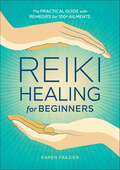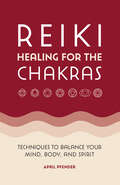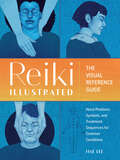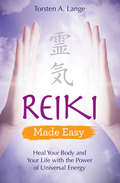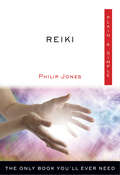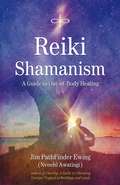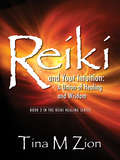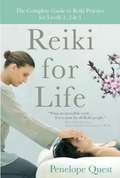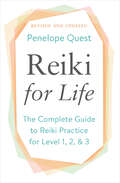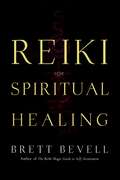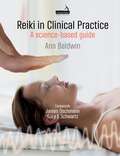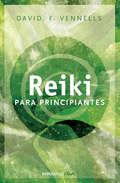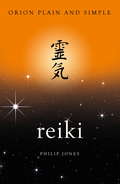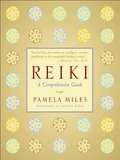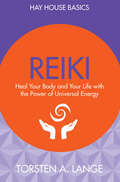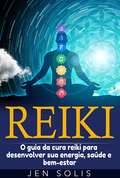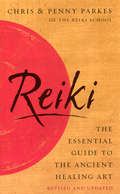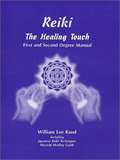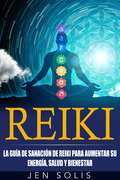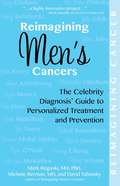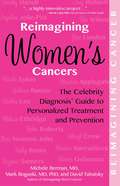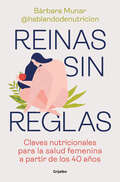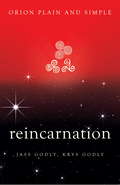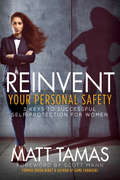- Table View
- List View
Reiki Healing for Beginners: The Practical Guide with Remedies for 100+ Ailments
by Karen FrazierLearn to treat over 100 physical and emotional ailments with remedies from Reiki Healing for Beginners.Reiki Healing for Beginners shows new reiki practitioners how to put theory into practice and start healing body, mind, and soul. This application-focused beginner's handbook explores basic reiki techniques, and teaches you how to heal over 100 common emotional and physical ailments with reiki. Through clear, step-by-step instructions—fully illustrated—this practical guide is the perfect companion for new reiki practitioners who learn by doing.From aches and pains to abundance and prosperity, reiki places the power to heal in your hands. Learn how to use reiki to heal yourself and others with:Remedies for 100+ ailments that provide clear instruction for treating physical and mental afflictions with reikiBasic reiki techniques that offer simple, step-by-step guidance on hand positions for reiki healingAn essential introduction that teaches you fundamental information on the history and principles of reikiTake a hands-on approach to healing with over 100 remedies from Reiki Healing for Beginners.
Reiki Healing for the Chakras: Techniques to Balance Your Mind, Body, and Spirit
by April PfenderHeal and balance your chakras through the power of reiki Chakra healing and reiki originate from different traditions but they are organically linked, focusing on healing and manipulating the energy that moves through us. This reiki book is your guide to combining the power of your chakras with the art of energy healing. You'll learn how to let your energy flow freely so your mind and body can thrive. The reiki-chakra connection—Learn how to use specific reiki techniques to heal and align each of your main chakras, improving every aspect of your well-being. For all experience levels—Whether this is your first foray into energy healing or you have an established practice, you'll find clear explanations that help you understand the core tenets of both reiki and chakras. Clear illustrations—Find illustrations that explain hand positions, reiki symbols, chakra locations, and more, to help ensure success as you learn to heal yourself and others. Use energy safely, gently, and effectively to heal inside and out with Reiki Healing for the Chakras.
Reiki Illustrated: The Visual Reference Guide of Hand Positions, Symbols, and Treatment Sequences for Common Conditions
by Hae LeeA fully illustrated reference guide for Reiki practitioners of all levels of experience.With Reiki Illustrated by Hae Lee, Reiki healers now have a practical resource that presents Reiki symbols, hand placements, and treatment sequences in an accessible, visual way. From the newly attuned Reiki student to the experienced Reiki Master that certifies and trains others, Reiki practitioners will find a wealth of information in this book to strengthen their connection to this beautiful healing modality. Clear illustrations of 40 hand positions for treating the self and others, featuring diverse bodiesConcise overview of Reiki symbols including usage and stroke-by-stroke drawing instructionsStep-by-step treatment sequences for 80 health issues or concerns ranging from pain and fatigue to grief or low self-esteem Annotated figures for each sequence including numbered markings indicating where hands should be moved
Reiki Made Easy: Heal Your Body and Your Life with the Power of Universal Energy
by Torsten LangeA fascinating, simple and practical introduction to the Reiki healing system.Reiki is one of the most popular energy-healing systems, founded in Japan and now used all over the world. It's easy to learn, and everyone can benefit from it. Written by the founder of the Reiki Academy London, Torsten A. Lange, Reiki Made Easy is a comprehensive yet accessible guide to the powerful Reiki healing system, showing how it can be used for physical, emotional, mental and spiritual healing. This book explores:- the history of Reiki, including new information not currently found in any other book- how to connect to Reiki energy to heal ourselves and others- the symbols of Reiki and how to work with them- how to give a distant healing- real-life stories that demonstrate the deep healing this system offers- the steps to becoming a Reiki practitionerFor anyone wishing to learn how to apply the benefits of Reiki in their lives, this book is a perfect starting point on their journey.
Reiki Plain & Simple: The Only Book You'll Ever Need (Plain & Simple Series)
by Philip JonesSince originating in Japan in 1922, Reiki has been adapted to cultural traditions across the world. Reiki practitioners use a technique called palm healing or hands-on healing through which a “universal energy” is transferred through the palms of the practitioner to the patient in order to encourage emotional or physical healing. <P><P>Reiki is used for healing oneself and others and for spiritual development. It works by combining two things: initiations that awaken and open your energy channels and techniques for using your hands, eyes, and intention to direct this energy flow where needed. Anyone who wishes to do this work must prepare by following particular methods and steps, all wonderfully explained in this introductory guide. <P><P>Discover why Reiki is so unique and learn about its origins, five precepts, attunements, basic hand positions, and special treatments created by Reiki’s founder, Mikao Usui. All the spiritual practices here have been specifically chosen to guide readers on a path of love, light, healing, and self-knowledge.
Reiki Shamanism
by Jim Pathfinder EwingAnyone with a rudimentary knowledge of either Reiki or shamanism will learn how to heal people, places, and things, whether at hand or from a distance, in this useful guide. Presented by an expert in both traditions, the techniques of Reiki and the principles of shamanism are explained in simple, concise terms, then brought together using real-life examples to show how Reiki can be practiced within the shamanic journey. Supported by mastery exercises, references to other books, and internet resources, both novices and experienced practitioners will expand their knowledge and ability to help subjects clear old energies and accelerate their "soul purpose."
Reiki for Life
by Penelope QuestA comprehensive guide to the practice of Reiki techniques for the beginner and more experienced Reiki practitioner, this guidebook examines first-, second-, and third-degree Reiki. The volume explains what Reiki is and how it works; how to use Reiki to heal; provides a detailed explanation of the use of Reiki symbols and second-degree Reiki; introduces Reiki-ho; outlines the path to becoming a Reiki master and third-degree Reiki; and shows how to grow spiritually with Reiki.
Reiki for Life
by Penelope QuestThe must-have guide to self-healing and treating others with Reiki. An exciting and comprehensive handbook, Reiki for Life contains everything readers need to know about the healing art of Reiki. This practical guide covers all points: basic routines, details about the power and potential of each level, special techniques for enhancing Reiki practice, and helpful direction on the use of Reiki toward spiritual growth. Penelope Quest also compares the origins and development of Reiki in the West and the East, revealing methods specific to the original Japanese Reiki tradition. Suitable for beginners, experienced practitioners, and teachers alike, this book: *explains what Reiki is and how it works; *gives detailed instruction in First and Second Degree techniques; *illustrates how to perform Reiki on yourself, as well as others; *advises on how to become a Reiki Master/teacher; and *includes special advanced methods for working with Reiki. Complete with illustrations and a useful section of resources, Reiki for Life is a must-have for the tens of thousands of Western seekers anxious to learn about this fast-growing healing practice.
Reiki for Life (Updated Edition): The Complete Guide to Reiki Practice for Levels 1, 2 & 3
by Penelope QuestThe classic text suitable for Reiki beginners and masters alike--now revised and updated with the latest findings and techniques into this arcane energy healing practice An exciting and comprehensive handbook, Reiki for Life contains everything readers need to know about the healing art of Reiki, including basic routines, details about the power and potential of each level, special techniques for enhancing Reiki practice, and helpful direction on the use of Reiki toward spiritual growth. Comparing the origins and development of Reiki in the West and the East, revealing methods specific to the original Japanese Reiki tradition, and suitable for beginners, experienced practitioners, and teachers alike, this book: * Explains what Reiki is and how it works.* Gives detailed instruction in First and Second Degree techniques.* Illustrates how to perform Reiki on yourself, as well as on others.* Advises on how to become a Reiki master/teacher.* Includes special advanced methods for working with Reiki. Complete with illustrations and a useful section of resources, Reiki for Life is a must-have for seekers anxious to learn about this fast-growing healing practice.From the Trade Paperback edition.
Reiki for Spiritual Healing
by Brett BevellA Doorway to Spiritual Awakening In this groundbreaking guide, Reiki Master Brett Bevell reveals how to focus the energy of Reiki--traditionally used for healing the body--toward healing the spirit. By showing how to work with the Higher Self to send Reiki treatments across many lifetimes, Bevell provides the tools for clearing karmic and spiritual blocks at the moment they were created. Through the introduction of new Reiki symbols and techniques for forgiveness, accessing the angelic realm, and more, seekers will be able to take ownership of their connection to the Divine and engage in real change in their lives.From the Trade Paperback edition.
Reiki in Clinical Practice: A science-based guide
by Ann BaldwinReiki is a healing technique, using gentle touch with the hands placed on or slightly away from the body to optimize physical, mental and emotional health. It is based on the assumption that the flow of energy through the body can be supported and adjusted to promote wellness.Reiki in Clinical Practice is aimed at two main groups: 'medical' practitioners and those with a 'medical' background such as nurses, osteopaths, physical therapists, who may be familiar with Reiki but lack an evidence-based guide on conditions for which Reiki is most effective and who want the 'ammunition' to justify its use in their practice; those unfamiliar with Reiki but who are interested in finding how it can benefit their patients.The book provides an accurate description of Reiki, based on qualitative and quantitative scientific evidence, in terms of how it can be used in medical settings to benefit patients of all types, physiologically and psychologically. It achieves this by following the journey of the author (a scientist), starting from her unsolicited encounter with Reiki and personal observations to her continuing testing of its validity and her quest to determine its effectiveness through robust, scientific investigation.The author distils the essence of the currently peer-reviewed published research to produce a clear outline of the effectiveness of Reiki in alleviating disease and imbalance in various body systems. She will provide a summary of the effectiveness of Reiki (based on a review of surveys of its use) in various circumstances and locations.She presents possible mechanisms by which Reiki may exert its effects. Unlike most books about Reiki, the book is written in a scientific style with which medical practitioners are familiar (clear, precise, logical and concise), so they will be more likely to read it, judge the evidence for themselves, and hopefully support, extend and develop Reiki treatment and training programs so that their patients will have more access to a non-invasive, inexpensive complementary therapy to assist in their healing.
Reiki para principiantes
by David VennellsMillones de personas alrededor del mundo se han beneficiado del reiki. Gracias a este libro introductorio, ahora tú también conocerás los principios básicos de este sistema simple, pero profundo que te conducirá a través de los distintos niveles energéticos hacia la sanación y el crecimiento espirituales. Entre otras cosas, con Reiki para principiantes aprenderás a:o Curar diversas enfermedades y padecimientos físicos, mentales y emocionales.o Resolver problemas en el trabajo y en el hogar.o Ser más creativo, mejorar tu memoria y sentirte guiado y protegido en todo momento.o Desarrollar la compasión, la sabiduría, la paciencia y la empatía.Además de narrar la fascinante historia de esta técnica ancestral, este libro te guiará por sus tres grados de aprendizaje y te mostrará la estrecha relación que existe entre esta práctica, la meditación y el budismo. Como resultado, aprenderás a tratar con reiki tu propio cuerpo y el de los demás.
Reiki, Orion Plain and Simple (Plain and Simple)
by Philip JonesA pracitcal guide to opening and strengthening your reiki channels.Since originating in Japan in 1922, Reiki has been adapted to cultural traditions across the world. Reiki practitioners use a technique called palm healing or hands-on healing through which a "universal energy" is transferred through the palms of the practitioner to the patient in order to encourage emotional or physical healing.Reiki is used for healing oneself and others and for spiritual development. It works by combining two things: initiations that awaken and open your energy channels and techniques for using your hands, eyes, and intention to direct this energy flow where needed. Anyone who wishes to do this work must prepare by following particular methods and steps, all wonderfully explained in this introductory guide.Discover why Reiki is so unique and learn about its origins, five precepts, attunements, basic hand positions, and special treatments created by Reiki's founder, Mikao Usui. All the spiritual practices here have been specifically chosen to guide readers on a path of love, light, healing, and self-knowledge.
Reiki: A Comprehensive Guide
by Pamela MilesPerhaps the gentlest alternative healing therapy in the world, Reiki has gone mainstream. A form of energy healing developed in early twentieth-century Japan, Reiki is rapidly breaking into conventional medicine because of its ease of use, its immediate benefits, and, perhaps most important, the element of self-care inherent in the practice. And yet, Reiki remains a mysterious healing art due to the paucity of reliable resources on this therapy. For those who seek guidance in bringing Reiki into their lives, Pamela Miles's Reikiis bound to become an indispensable friend. Considered by many to be the country's foremost Reiki expert, Miles introduces the newcomer to the history of Reiki; offers descriptions of firstdegree, second-degree, and Master training; and details how individuals can treat themselves. For the advanced practitioner, she provides in-depth insight into continued practice as well as information on current and forthcoming research that will lead to greater integration of this healing therapy into conventional medicine. Among the first Reiki Masters to bring this healing therapy into hospitals, Pamela Miles uses her unique background to explain how Reiki complements conventional medical treatments and helps patients recover from invasive surgical procedures. Reikialso discusses the way Reiki can ease the symptoms of conditions such as AIDS, cancer, insomnia, depression, anxiety, and more, as well as the side effects of medication. With compassion, wisdom, and more than thirty years' experience as a healer, Miles shows readers how simple-and powerful-it is to take an active role in their own well-being by using one of the fastest-growing alternative therapies in the world.
Reiki: Heal Your Body and Your Life with the Power of Universal Energy
by Torsten A. LangeDiscover the key benefits, major techniques, and spiritual essence of the system of Reiki. This book explores: •the history of Reiki, including new information not currently found in any other book •the original techniques and ways to bring them to life for everyday use •real-life stories that demonstrate the deep healing this system offers •'The Reiki Principles' and how you can embrace them in your life •the symbols of Reiki and how to work with them …and much more!Hay House Basics is a new series that features world-class experts sharing their knowledge on the topics that matter most for improving your life.
Reiki: O guia da cura reiki para desenvolver sua energia, saúde e bem-estar
by Jen SolisFrequentemente temos consciência de que estamos desequilibrados de alguma forma mas não conseguimos entender porquê. Dor, por exemplo, é uma manifestação física de desequilíbrio energético. Doenças também podem ser um efeito colateral, já que o sistema imunológico é comprometido. A cura Reiki é algo que pode ser praticado com segurança no dia-a-dia e se você não se sente bem, o Reiki pode ajudá-lo a se recuperar mais rapidamente. O guia da cura reiki pode ajudá-lo a alcançar bem-estar físico e mental através de técnicas que vamos lhe mostrar. A melhor parte do Reiki é que mesmo que você esteja focado em curar uma parte de sua vida, os seus esforços irão afetar todas as partes de sua vida e naturalmente retornar para o equilíbrio. Uma vez que você estiver familiarizado com o processo de equilíbrio, você pode inclusive doar energia a outros usando as técnicas de sintonização que manipulam o campo energético e permitem que você interaja com a energia diretamente. Há muitas técnicas orientais que trabalham com a energia Qi, então por que escolher o Reiki? Você descobrirá isto e mais neste livro.Neste livro você encontrará as respostas para essas perguntas e mais. Algumas das questões e tópicos são: Reiki básico Cura com Reiki Energia Qi Chakras Claridades e cristais Clarividência Clarisciência Clariaudiência Claricognição Praticando Reiki O processo de sintonizaçãp Nível 2 Nível 3/Mestre Reiki Escaneamento do corpo (body scans) Escaneamento de Auras Escaneamento com pêndulos E mais!
Reiki: The Essential Guide to Ancient Healing Art
by Penny Parkes Chris ParkesReiki is a Japanese word meaning Universal Life Force Energy. Drawing on ancient practices, which are said to have dated back to Buddha, Reiki balances the energy in the body, renewing vitality and bringing about a powerful feeling of serenity and relaxation through the laying on of hands. Reiki can be used to relieve the problems associated with stress, tension, chronic illness and post-operative pain. In this revised and updated edition Chris and Penny Parkes explain what to expect from a treatment, how it works and how it can be of benefit - and even show how you too can train (very easily) to practice Reiki. Written by one of the few Reiki masters in the UK and featuring the original Usui method, this practical and accessible book reveals the fascinating story behind the discovery of Reiki.
Reiki: The Healing Touch, First and Second Degree Manual
by William Lee Rand<p>The knowledge that an unseen energy flows through all living things and directly affects the quality of health has been part of the wisdom of many cultures since ancient times. The existence of this "life energy" has been verified by recent scientific experiments, and medical doctors are considering the role it plays in the functioning of the immune system and the healing process. <p>Reiki, a technique for stress reduction that also promotes healing, allows everyone to tap into an unlimited supply of "life energy." Reiki was discovered by Dr. Mikao Usui, a Japanese Buddhist, early in the 20th Century. Reiki is easy to learn. It has been successfully taught to thousands of people of all ages and backgrounds. A treatment feels like a wonderful glowing radience that flows through you and surrounds you. It creates many beneficial effects including relaxation and feelings of peace, security and well being. Many have reported miraculous results. Hospitals and doctors' offices are beginning to include it as part of their therapy, and this new edition describes several successful approaches now being used across the US to integrate Reiki into patient care. <p>This revised and expanded edition includes important new information on the theory and practice of Reiki, including the Japanese Reiki Techniques taught by Dr. Usui as well as the Hayashi healing guide. Also included are pictures of the Usui Memorial in Tokyo, and of Mt. Kurama where Reiki was rediscovered. <p>This book is a must for anyone wanting the latest information on Reiki. Its referenced history of Reiki contains the most detailed and verfiable information currently available. Written with inspiration, clarity and vitality, it captures the essence of Reiki and is an excellent introduction to the subject as well as a user-friendly manual for the experienced practitioner.</p>
Reiki: la guía de sanación de Reiki para aumentar su energía, salud y bienestar
by Romina P. Piscione Jen SolisSolemos ser conscientes de que nos sentimos desequilibrados de alguna manera, pero no podemos entender por qué. El dolor, por ejemplo, es una manifestación física del desequilibrio energético. La enfermedad también puede ser un efecto secundario de esto, ya que compromete el sistema inmune. La curación con Reiki es algo que se puede practicar de forma segura todos los días, y si no se siente bien, el Reiki puede ayudar a que se recupere y se sienta mejor más rápido. La Guía de sanación de Reiki puede ayudarle a lograr un mejor bienestar físico y mental a través de las técnicas que estamos a punto de mostrarle. Lo bueno del Reiki es que incluso cuando se enfoca en sanar una parte de su vida, sus esfuerzos afectarán todas las partes de su vida y las ayudará a regresar naturalmente a un equilibrio óptimo. Una vez que esté familiarizado con el proceso de equilibrio, también puede dar energía a otros mediante la utilización de técnicas de sintonización que manipulan el campo de energía y le permiten interactuar directamente con ella. Hay muchas técnicas orientales que dependen de la energía Qi, ¿por qué elegir Reiki? Descubrirá todo eso y más aquí. En este libro encontrará las respuestas a estas preguntas y más. Algunas de las preguntas y temas incluidos son: Los fundamentos del Reiki Curación con Reiki Energía Qi Chakras Claros y cristales Clarividencia Clarisentencia Clariaudiencia Claricognisencia Practicar Reiki El procedimiento de sintonización Nivel 2 Nivel 3 /Master Reiki Escaneos corporales Escaneo de aura Escaneo de péndulo ¡Y más! ¡No dude en recoger su copia hoy!
Reimagining Men's Cancers: The Celebrity Diagnosis Guide to Personalized Treatment and Prevention (Reimagining Cancer)
by David Tabatsky Michele Berman Mark BoguskiAmerica's fascination with celebrities never gets old. From People magazine, with a readership of 43 million to Internet sites like JustJared.com with over 80 million monthly views, celebrity information not only sells, it educates people about important issues––including cancer. Information is empowering and reading about a famous person coping with cancer can not only be inspiring, it can save a life. That's what Reimagining Cancer exemplifies through each of the books in the series Cancer doesn't have to be a death sentence. About half of all cancers are preventable and can be avoided if current medical knowledge is better delivered*. Reimagining Men's Cancers—focusing on cancers of the prostate, penis, and testicles—provides readers with that critical information to help them manage, cope, and recover through a concise, easy-to-read style and format. Beginning with a view of basic anatomy and an overview of how we view a particular cancer today, chapters flow easily into an explanation of signs, symptoms, diagnosis, scientific information and guidelines, and include a comprehensive survey of treatments and prevention. Woven throughout are stories, both medical and anecdotal, from men such as Joe Torre, Robert De Niro, Sir Ian McKellen, and Scott Hamilton. Education is the key, and by using celebrity stories, Reimagining Men's Cancers can attract countless readers who might otherwise not pay attention to an epidemic that is likely to affect them or a loved one. * The recent World Cancer Report from the World Health Organization
Reimagining Women's Cancers: The Celebrity Diagnosis Guide to Personalized Treatment and Prevention (Reimagining Cancer)
by David Tabatsky Michele Berman Mark BoguskiAmerica's fascination with celebrities never gets old. From People magazine, with a readership of 43 million to Internet sites like JustJared.com with over 80 million monthly views, celebrity information not only sells, it educates people about important issues––including cancer. Information is empowering and reading about a famous person coping with cancer can not only be inspiring, it can save a life. That's what Reimagining Cancer exemplifies through each of the books in the series Cancer doesn't have to be a death sentence. About half of all cancers are preventable and can be avoided if current medical knowledge is better delivered*. This new series, beginning with Reimagining Women's Cancers—focusing on cancer of the breasts, ovaries, uterus, cervix, vagina and vulva—provides readers with that critical information to help them manage, cope, and recover through a concise, easy-to-read style and format. Beginning with a view of basic anatomy and an overview of how we view a particular cancer today, chapters flow easily into an explanation of signs, symptoms, diagnosis, scientific information and guidelines, and include a comprehensive survey of treatments and prevention. Woven throughout are stories, both medical and anecdotal, from women such as Angelina Jolie, Joan Lunden, Melissa Etheridge, Sandra Lee, Rita Wilson, Christina Applegate, and Suzanne Somers. Education is the key, and by using celebrity stories, Reimagining Women's Cancers can attract countless readers who might otherwise not pay attention to an epidemic that is likely to affect them or a loved one. * The recent World Cancer Report from the World Health Organization
Reinas sin reglas: Claves nutricionales para la salud femenina a partir de los 40 años
by Bàrbara MunarLa conocida dietista de Instagram @hablandodenutricion, nos da las claves para mantener una buena salud femenina a partir de los 40 años. Un libro generoso, práctico y basado en la ciencia de vanguardia que permitirá entrar con muy buen pie en la menopausia para vivirla libres, sin síntomas y felices, como verdaderas Reinas sin Reglas. Las mujeres vivimos más de un tercio de nuestra vida sin menstruar, pese a ello la menopausia y el climaterio son un gran desconocido para la mayoría de nosotras porque la experiencia de esta época ha sido un tabú que relacionábamos con la vejez y con el fin de la feminidad. Durante el climaterio el sistema hormonal se altera y causa cambios físicos y psicológicos, pese a ello, es una etapa que puede ser maravillosa, pero dependerá de nuestra actitud y de la información veraz que manejemos tanto en los años previos como durante esta etapa. Este libro responde a preguntas como: ¿Por qué aumentamos de peso a partir de los 40? ¿Por qué nos falta energía o tenemos tantos cambios de humor? ¿Por qué se nos hincha la barriga o tenemos menos deseo sexual? ¿Cómo podemos reducir los sofocos? Y nos da herramientas para que aprendamos que, comiendo variado, centrándonos en la calidad y sin contar calorías podemos perder contorno, desinflamarnos, tener más energía, mejorar tu calidad de sueño, tu libido y reducir los sofocos.
Reincarnation, Orion Plain and Simple (Plain and Simple)
by Jass Godly Krys GodlyA practical guide on how to access information about our previous lives.From ancient roots in Hinduism, Buddhism, and Greek philosophy to more modern conceptions of rebirth found in popular culture, the notion that the soul can be reborn is a prevalent belief that continues to fascinate. That fascination inevitably results in a number of questions, including: How does our day-to-day life impact our future existences? Who were we before we were born? How do we find out about our previous incarnations?This practical guide attempts to answer these questions and much more. The Godlys provide step-by-step instructions for accessing information about our previous lives and explore the four main methods of learning about past lives: · Recession· Psychic readings· Regression· Spontaneous recallThey also explore how reincarnation can help us to understand re-occurrences of relationships, lingering memories, and even health problems.This is a refreshing and simple introduction to a topic that has intrigued seers, sages, and mystics for centuries. It entertains, enlightens, and informs.
Reinvent Your Personal Safety: 3 Keys to Successful Self-Protection for Women
by Matt TamasIn Reinvent Your Personal Safety, Matt Tamas takes women through a proactive approach to personal safety, one that isn’t about honing technical moves or perfecting technique, but more about showing them how to work with their own body and mind, considering realistic scenarios, and training them to take appropriate action. Matt’s job, as a personal safety coach, is to not only give women the tools to fight back during an assault, but also to help them prevent themselves from being assaulted in the first place. The right action to take is often in advance of a likely violent encounter in order to avoid it altogether. The best way to protect one’s self is avoiding the situation in which she is forced to defend herself. Reinvent Your Personal Safety talks about the different ways this is possible, as well as about the best way to handle one’s self when violent confrontation simply cannot be avoided. This is for the high-school girl, for the grandmother, for the young professional, for the working mother – anyone who is willing to overcome their limiting beliefs about what they’re capable of and key into what self-protection is really about. In reality, knowledge of the appropriate action to take in any given situation is worth scores more than athleticism.
